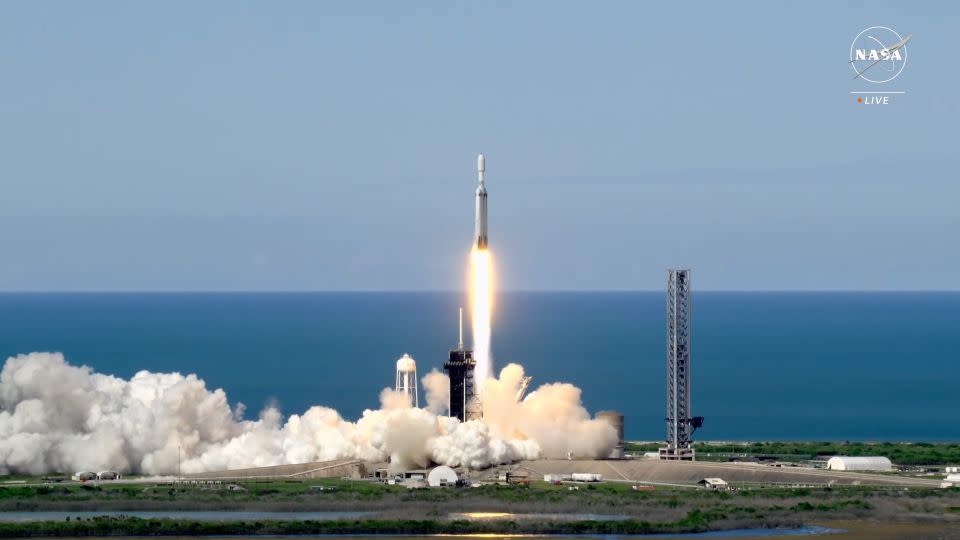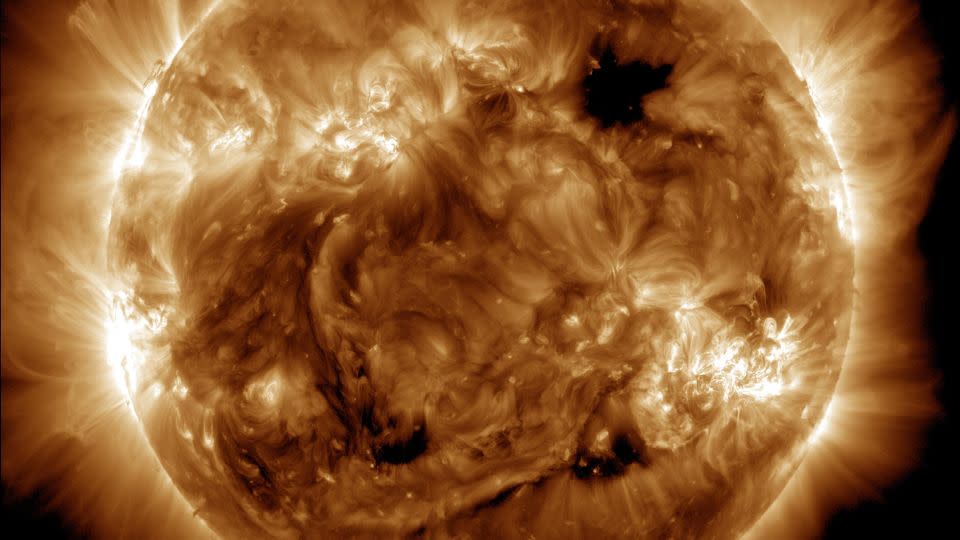Sign up for CNN’s Wonder Theory science newsletter. Explore the universe with news about fascinating discoveries, scientific breakthroughs and more.
Forecasters will soon be able to see a real-time map of lightning activity on Earth and keep a closer eye on solar storms unleashed by the sun, thanks to a new weather satellite.
NASA and the National Oceanic and Atmospheric Administration together launched the GOES-U, or Geostationary Operational Environmental Satellite U mission, on Tuesday.
The weather satellite took off from the Kennedy Space Center in Florida on a SpaceX Falcon Heavy rocket at 5:26 p.m. The launch was streamed live on NASA’s website. Weather conditions in Florida were 60% favorable for launch at the beginning of the launch window.
GOES-U is the fourth and final satellite in the R Series of Geostationary Operational Environmental Satellites, “the Western Hemisphere’s most advanced weather observation and environmental monitoring system,” according to NOAA.
“The GOES-R series satellites have been a game-changer for us,” NOAA National Weather Service director Ken Graham said at Monday’s press conference. “Since the series’ initial launch in 2016, the latest generation GOES has enabled new and improved forecasting and warning services to help save lives and protect property.”

Once GOES-U reaches a geostationary orbit or a circular orbit above the Earth’s equator, the satellite will be renamed GOES-19 or GOES East. The satellite will replace GOES-16, the older GOES East satellite launched in 2016, and will operate alongside GOES-18, also called GOES West. Meanwhile, the GOES-16 satellite will become the system’s in-orbit backup in case one of the satellites fails.
Together, the GOES-18 and GOES-19 satellites will collect atmospheric, solar, climate and ocean data and will cover more than half the globe, from the west coast of Africa to New Zealand.
What distinguishes GOES-U from other satellites is that it carries a new ability to monitor space weather.
Tracking solar activity
The sun becomes more active as it approaches solar maximum (the peak of its 11-year cycle expected this year). Researchers have observed increasingly intense solar flares and coronal mass ejections from the sun’s surface.
Coronal mass ejections are large clouds of ionized gas, called plasma, and magnetic fields released from the sun’s outer atmosphere.
When these bursts are directed towards the Earth, they can cause geomagnetic storms or major disturbances in the Earth’s magnetic field. There is always the possibility that communications, power grid, navigation, radio and satellite operations may be affected by these events.


The most intense solar storm to impact Earth in the last 20 years occurred on May 10, but fortunately this storm only caused auroras to shine over states that never see the northern lights.
Increased solar activity causes dancing auroras around the Earth’s poles, known as the northern lights, or aurora borealis, and the southern lights, or aurora australis. When energetic particles from coronal mass ejections reach the Earth’s magnetic field, they interact with gases in the atmosphere, creating different colored lights in the sky.
GOES-U carries multiple instruments that will improve detection of space weather hazards, including Compact Coronagraph-1, which can detect solar flares and coronal mass ejections and characterize the size, speed, intensity, and direction of these solar storms.
Elsayed Talaat, director of NOAA’s Space Weather Observation Office, said the coronagraph will provide continuous observations of the solar corona, or the hot outer layer of the sun’s atmosphere (where space weather events occur).
The device’s capabilities will allow NOAA’s Space Weather Prediction Center to provide warning and monitoring one to four days in advance and “open a new chapter in space weather observations,” Talaat said.
Compact Coronagraph-1 is the world’s first operational satellite coronagraph that better tracks the sun, said Steve Volz, deputy administrator of NOAA’s Satellite and Information Service.
“This new instrument will deliver images of the sun’s corona to our forecasters at the Space Weather Prediction Center in 30 minutes, compared to what previously took about eight hours,” Graham said. “Geomagnetic storms can impact our infrastructure on Earth, putting our energy grid, communications, navigation systems, and aerospace-based assets at risk. “Having better and faster monitoring will help us better alert our infrastructure providers and potential hazards so they can take action.”
Lightning strikes in real time
GOES-U will monitor weather, climate and environmental hazards from orbit in North, Central and South America, the Caribbean and from the Atlantic Ocean to the west coast of Africa.
GOES-U will be able to detect tropical storms from its unique vantage point, send alerts to forecasters when storms form in the Atlantic Ocean, and provide near real-time tracking and monitoring.
The satellite carries a suite of scientific instruments, including imaging and mapping technology, that will allow it to capture valuable data about hurricanes, including upper-end wind speeds, the eye of the hurricane, and specific features related to lightning activity, all of which can better assist forecasters. Understand the potential risks.
GOES-U will carry the first operational lightning mapper to fly in geostationary orbit. As storms develop, they tend to show sudden increases in lightning activity. Understanding how storms develop and intensify can help meteorologists better predict whether storms will cause flash flooding, hail, damaging winds or tornadoes.
The lightning mapper will take pictures of the Earth 500 times per second to track lightning like never before, Sullivan said.
The main camera on GOES-U can zoom in to view hazardous weather and environmental conditions every 30 seconds, allowing for better warning systems, said Pam Sullivan, director of NOAA’s GOES-R program.
Forecasters can also use GOES-U’s tools to identify wildfire risks, including hot spots, density, smoke output and air quality impacts, and even data that can help trackers predict the movement of fires. The satellite can also use its lightning mapper to determine which lightning strikes are most likely to trigger wildfires.
Other environmental hazards that GOES-U can monitor include real-time images of fog and low clouds that could affect air and sea travel, as well as detecting volcanic eruptions and ash and sulfur dioxide spewed by volcanoes. GOES-U will also be able to monitor atmospheric river events, or large sections of the Earth’s atmosphere that carry moisture from the equator to the poles, which can cause floods and mudslides.
In addition to early warning of hurricane formation, GOES-U can also collect climate data about Earth’s oceans, such as marine heat waves and sea surface temperatures, which affect the marine food chain and can lead to mass coral bleaching events.
For more CNN news and newsletters, create an account at CNN.com